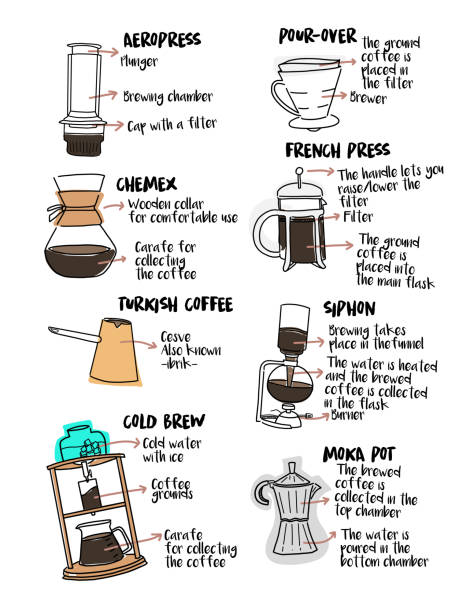Coffee Brewing Methods Demystified: From French Press to Cold Brew
Coffee Brewing Methods Demystified: From French Press to Cold Brew
Blog Article
Exploring the Art of Coffee Brewing: A Comprehensive Overview to Perfecting Your Mug
The art of coffee brewing is a multifaceted self-control that merges scientific research with individual expression, where the selection of beans, water quality, and brewing techniques assemble to develop a polished sensory experience. Recognizing the subtleties of various coffee beans, particularly the distinctions in between Arabica and Robusta, is important for any kind of enthusiast.
Recognizing Coffee Beans
To absolutely value the art of coffee brewing, one have to first understand the fundamental element: coffee beans. Coffee beans primarily drop right into two classifications: Arabica and Robusta.

In addition, the handling technique-- whether cleaned, natural, or honey-- affects the beans' final taste. Recognizing these elements enables brewers to pick the appropriate beans that straighten with their favored taste account, eventually enhancing the coffee brewing experience. coffee brewing methods. This understanding is vital for any person desiring understand the craft of making the ideal mug of coffee
Developing Approaches Discussed
Numerous enthusiasts discover that the option of brewing technique significantly influences the final flavor and aroma of their coffee. Each method takes advantage of different extraction strategies, affecting the coffee's character and splendor.
Drip developing, one of the most preferred methods, makes use of a device to drip warm water through ground coffee, generating a regular and tidy mug. French press, on the various other hand, submerses coffee grounds in hot water, permitting a fuller body and more durable flavor, as oils and great particles continue to be in the brew.
Pour-over brewing offers a precise technique, where water is manually poured over coffee premises, permitting specific control over extraction time and temperature, resulting in a nuanced and bright cup.
Espresso, a concentrated coffee made under stress, is recognized for its strong taste and creamy appearance, offering as the base for different coffee beverages, including cappucinos and cappuccinos.
Necessary Devices Required
The foundation of any kind of successful coffee developing process lies in high quality equipment tailored to your preferred approach. A trustworthy coffee mill is vital; freshly ground beans substantially enhance taste and scent.
Following, consider your brewing tool. Options vary from drip coffee makers and pour-over arrangements to French presses and coffee makers. Each technique supplies distinct flavor accounts and developing techniques, so select one that straightens with your preference choices.
A precise range is likewise very useful, permitting you to determine coffee and water precisely, which is important for consistency. In addition, a thermometer can aid keep an eye on water temperature level, as it straight influences removal high quality.
Learning Water High Quality
The top quality of water utilized in brewing coffee plays a considerable duty in identifying the last flavor account of the mug. Different aspects add to water high quality, consisting of mineral material, pH degree, and total purity. Ideally, water should be without pollutants and impurities, as these can adversely influence the preference of coffee.
Minerals, such as calcium and magnesium, boost the removal of flavors from the coffee grounds, while keeping a well balanced pH level-- around 6.5 to 7.5-- is important for optimum extraction. Water that is too soft may bring about under-extraction, resulting in weak or sour tastes, while extremely hard water can create a bitter or rough mug.
For the very best results, filtered water is advised, as it minimizes the presence of chlorine and various other unwanted substances often discovered in tap water. In addition, think about making use of water with an Overall Dissolved Solids (TDS) degree between 150-200 ppm, which is typically perfect for coffee brewing. By understanding water high quality, you can lay a strong structure for attaining a consistently excellent cup of coffee, enabling the distinct qualities of your picked beans to beam through.

Tips for Taste Enhancement
Enhancing the taste of your coffee can substantially raise your developing experience and bring out the one-of-a-kind nuances of your selected beans. To attain this, take into consideration numerous key aspects that affect taste.
Firstly, the grind size plays an essential function. A finer work raises extraction, leading to bolder flavors, while a coarser work yields a milder cup. coffee news brewing methods. Adjust continue reading this your work according to your developing method to accomplish ideal outcomes
Second of all, experiment with brew time. Over-extraction can lead to bitterness, while under-extraction outcomes in a sour preference. Go for a mixture time that stabilizes these extremes, normally in between 2 to 4 minutes, relying on your approach.
Brewing with water that is too warm can blister the coffee, while water that is as well amazing may fail to remove appropriate flavor. In conclusion, the art of coffee developing is a diverse practice that calls for a deep understanding of various components, consisting of bean selection, developing techniques, and water quality. By incorporating these elements, coffee enthusiasts can boost their brewing strategies, resulting in a cup that not only pleases personal choices but additionally showcases the abundant complexity of coffee tastes.
The art of coffee brewing is a complex self-control that merges scientific research with personal expression, where the selection of beans, water high quality, and developing techniques merge to produce a polished sensory experience.To really value the art of coffee brewing, one have to initially comprehend the foundational aspect: coffee beans. Developing with water that is as well warm can burn the coffee, while water that is also amazing might stop working to remove sufficient taste. In conclusion, the art of coffee brewing is a complex practice that calls for a deep understanding of numerous aspects, consisting of bean selection, brewing approaches, and water quality. By integrating these parts, coffee enthusiasts can raise their developing techniques, resulting in a cup that not just pleases personal preferences however additionally showcases the abundant intricacy of click to find out more coffee flavors.
Report this page